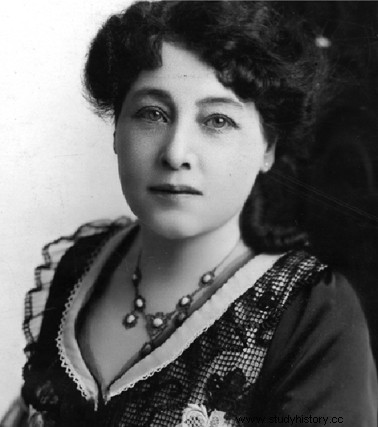Alice Guy Blaché (1873 – 1968), French filmmaker, was the first female director in the history of cinema, with The cabbage fairy filmed in 1896.
The cabbage fairy
 Fifth child of Marie Clotilde Franceline Aubert and Emile Guy, owners of a chain of bookstores in Chile, Alice was born in Paris in 1873. While her parents lived in Chile, Alice lived with her grandparents in Switzerland until the age of 3, when she joined her parents. She stayed in Chile, where she learned Spanish, until she was six years old when she returned to boarding school in France.
Fifth child of Marie Clotilde Franceline Aubert and Emile Guy, owners of a chain of bookstores in Chile, Alice was born in Paris in 1873. While her parents lived in Chile, Alice lived with her grandparents in Switzerland until the age of 3, when she joined her parents. She stayed in Chile, where she learned Spanish, until she was six years old when she returned to boarding school in France.
In Paris, Alice studied shorthand and at the age of 21 became a secretary at the Comptoir Général de la Photographie . In 1895, Léon Gaumont took over the management. He is only interested in technique and reporting, but Alice manages to obtain permission to shoot fiction films. She combined technique with the art of theater and, in 1896, made the film The cabbage fairy . She creates the role of director:choice of actors, costumes, sets, editing...
Until 1907, Alice directed the creation part of the Gaumont house. She hired assistants and decorators and made hundreds of films of all genres, including the assassination of the Lyon courier (1904), the Emerald (1905), Madam has desires (1906), The Life of Christ (1906). This life of Christ is the first big production, with 300 extras. Few of his films have survived until today.
A career in film
In 1907, Alice Guy married Herbert Blaché, an operator of the Gaumont agency in London, with whom she had two children. Léon Gaumont sends Herbert as director of the Gaumont firm in the United States and Alice follows him. In 1910, they created their own company, Solax, of which Alice was president, production manager and her “instigator” husband. In 1913, Herbert became president of a company that absorbed Solax. Alice continues to direct, but the cinema migrates to the West Coast in Hollywood and their company ends up being sold due to mismanagement by Herbert.
In 1920, Alice divorced and continued a career as a director in Hollywood, but she struggled to find a place in the film industry. She began to write stories for children and to give conferences in universities or cinematographic meetings. His work will only be truly recognized after his death; she bequeaths to the cinema the creation of the role of director and many new techniques, such as the use of close-ups, the projection of the film upside down or the use of wild animals.
